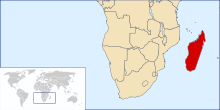Chrysiridia rhipheus
| Madagascan sunset moth | |
|---|---|
 |
|
| Engraving captioned Urania riphaeus from Charles D. d'Orbigny's Dictionnaire universel d'histoire naturelle (1849) | |
| Scientific classification | |
| Kingdom: | Animalia |
| Phylum: | Arthropoda |
| Class: | Insecta |
| Order: | Lepidoptera |
| Family: | Uraniidae |
| Subfamily: | Uraniinae |
| Genus: | Chrysiridia |
| Species: | C. rhipheus |
| Binomial name | |
|
Chrysiridia rhipheus (Drury, 1773) |
|
 |
|
| Endemic to Madagascar | |
| Synonyms | |
|
|
Chrysiridia rhipheus (Madagascan sunset moth) is a day-flying moth of the family Uraniidae. It is considered one of the most impressive and appealing-looking lepidopterans. Famous worldwide, it is featured in most coffee table books on Lepidoptera and is much sought after by collectors. It is very colourful, though the iridescent parts of the wings do not have pigment; rather the colours originate from optical interference. Adults have a wingspan of 7–9 cm (2.8–3.5 in).
Dru Drury, who described the moth in 1773, placed it in the genus Papilio, considering it a butterfly. Jacob Hübner placed it in the moth genus Chrysiridia in 1823. Later redescriptions led to junior synonyms such as Chrysiridia madagascariensis (Lesson, 1831).
At first the moth was thought to be from China or Bengal, but was later found to be endemic to Madagascar. It is found throughout the year in most parts of the island, with peak populations between March and August, and smallest numbers between October and December. Females lay about 80 eggs under the leaves of Omphalea spp. The caterpillars are whitish-yellow with black spots and red feet and are covered in club-ended black setae. Silk spun from the mouth helps the caterpillars hold on to smooth leaves and climb back to the plant when they fall. After completing four instars, the caterpillars spin an open network cocoon. The pupal stage lasts from 17 to 23 days.Chrysiridia rhipheus is the sole specialist herbivore of the four species of Omphalea in Madagascar. Omphalea is toxic: the toxins are sequestered by the feeding caterpillar and retained in the pupal and adult stages. Thousands of these moths migrate between the eastern and western ranges of their host plants.
...
Wikipedia
